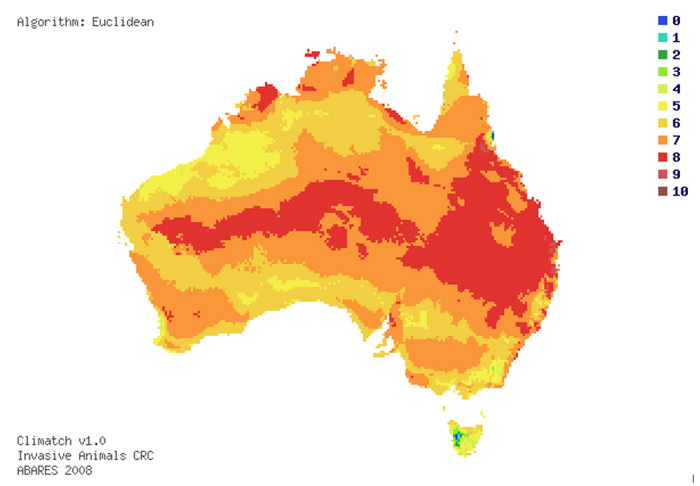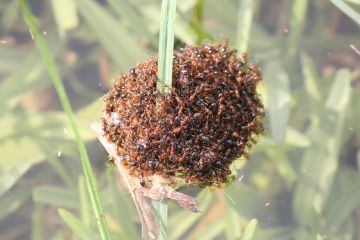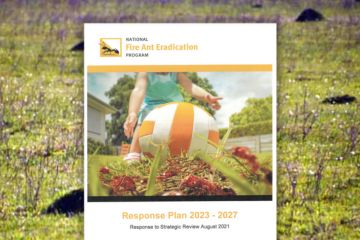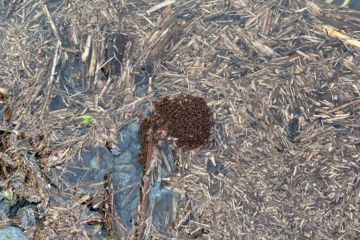In May 2016, the independent review of the red fire ant eradication program recommended that the program’s funding be enhanced from the current $18 million each year to $38 million each year.
So who will be paying to deliver this $38 million per year program for the 10 years needed to eradicate red fire ants from Australia?
In short, all governments of Australia will be paying. Funding will continue to be based on a national agreement where 50% is provided by the federal government with the balance of funding provided by each state and territory according to their population.
Determining state and territory government contributions
Normally each state and territory’s contribution would further depend on how each state would benefit from the program, based on the predicted uncontrolled spread of the invasive species in question. Those states that would ultimately end up with more of their state impacted by the particular pest or disease would pay proportionally more. However, for red fire ants ABARES climate modelling (see figure 1 below) predicts that between 99 and 100% of each mainland state and territory is susceptible to fire ants, while about 80% of Tasmania is likely to be affected. Tasmania thus pays a little less on a per capita basis.
Table 1 below shows the amount currently paid by each government and the amount proposed under the enhanced program.
Table 1: Respective government contributions to the national red fire ant eradication program, current (2016-17) and proposed under the enhanced $38 million per year eradication program.
| Government | % share1 | Current2 $ | Proposed $ |
| Federal | 50.0% | 7,500,000 | 19,000,000 |
| NSW | 16.9% | 2,535,000 | 6,422,000 |
| Vic | 12.4% | 1,860,000 | 4,712,000 |
| Qld | 9.4% | 1,410,000 | 3,572,000 |
| WA | 4.9% | 735,000 | 1,862,000 |
| SA | 3.9% | 585,000 | 1,482,000 |
| Tas | 1.2% | 180,000 | 456,000 |
| ACT | 0.8% | 120,000 | 304,000 |
| NT | 0.5% | 75,000 | 190,000 |
| Qld extra2 | 3,000,000 | – | |
| Total | 100.0% | 18,000,000 | 38,000,000 |
Notes
- Source: Standing Council of Primary Industries 3 May 2013 meeting resolution Annex B table 1. In 2017 the Invasive Species Council was informed that the % breakdown has been slightly modified for the program after July 2017 but has not received any figures.
- Allocations for 2016-17 per government based on $15 million expenditure.
- Queensland government contributed between $3M and $5.9M in additional funds each year from 2010-11 to 2015-16. Source: Magee, B. et. al. 2016. Independent review of the national red imported fire ant eradication program.

Spending over the last six years was supplemented by an additional $23.7 million from Queensland (20-40% on top of each year’s $15 million eradication budget) in recognition of the importance of eradication to their state and to encourage other states to fund for multi-year periods. For some years, Queensland was the largest funding contributor.
Western Australia stopped contributing to the eradication program for three years prior to 2017 due to their concerns about the running of the program and the belief that they could keep red fire ants from reaching their state.
Eradication spending as a proportion of biosecurity budgets
The Invasive Species Council has undertaken further analysis to compare each state’s contribution as a proportion of their current yearly agriculture expenditure. Where a government’s biosecurity expenditure could be determined, this percentage was also provided.
For South Australia, the enhanced red fire ant eradication program would make up 4.9% of their biosecurity budget or this year, followed by Queensland (3.2%) and the federal government (2.8%).
As a proportion of each government’s entire agriculture expenditure this year, the enhanced eradication funding would make up on average 1.2% of total expenditure, with the federal government (1.9%), Western Australia (1.6%) and Victoria (1.3%) exceeding the average. Table 2 below provides a full breakdown of these percentages.
Table 2: Proposed enhanced red fire ant eradication ($38m/year) as a proportion of government agriculture and biosecurity budgeted spending for 2016-17.
| Government |
Proposed $000 |
Total agriculture budget 2016-17 $000 |
% |
Biosecurity budget 2016-17 $000 |
% |
| Federal |
19,000 |
1,021,000 |
1.9% |
672,654 |
2.8% |
| NSW |
6,422 |
940,600 |
0.7% |
n/a |
n/a |
| Vic |
4,712 |
351,900 |
1.3% |
n/a |
n/a |
| Qld |
3,572 |
438,954 |
0.8% |
111,145 |
3.2% |
| WA |
1,862 |
118,434 |
1.6% |
66,208 |
2.8% |
| SA |
1,482 |
244,516 |
0.6% |
29,954 |
4.9% |
| Tas |
456 |
73,194 |
0.6% |
23,103 |
2.0% |
| ACT |
304 |
n/a |
n/a |
n/a |
n/a |
| NT |
190 |
62,747 |
0.3% |
12,184 |
1.6% |
| Total |
38,000 |
3,251,345 |
1.2% |
915,248 |
2.9% |
Notes
- All governments except ACT fund red fire ant eradication and other biosecurity activities from their agriculture portfolios.
- n/a – figures not readily available.
- Sourced from State budget papers and advice received from departmental officers.
The eradication of red fire ants is a truly national program, funding by all governments based on each government’s capacity to pay and the extent that the fire ant will infest that state in the longer term.
All Australian’s should be rightly concerned about the prospect of fire ants directly impacting their lives – whether it is making their backyards and picnic areas unusable, impacting their business, or damaging the environment they value. We should therefore be demanding that our state or territory government and the federal government allocate the needed funds to do the job of eradicating the ants.




